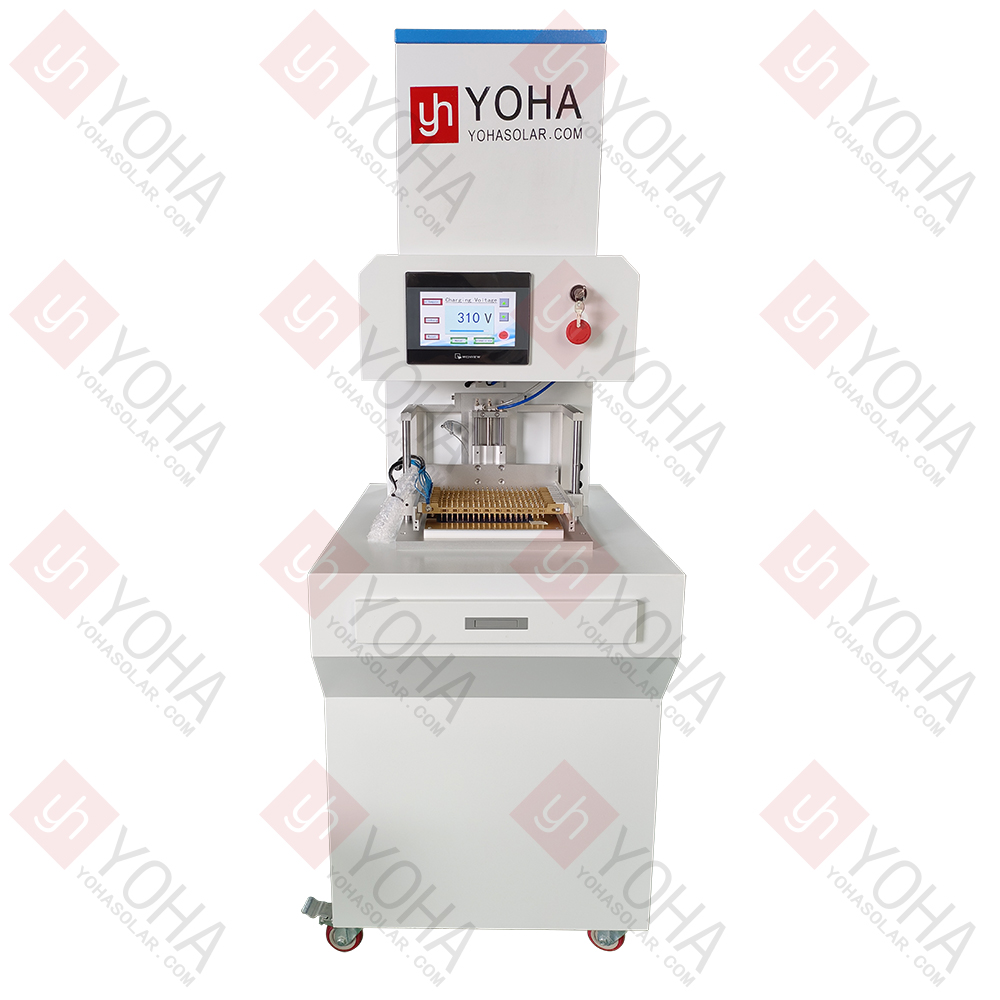Welcome to Wuhan Yoha Solar Technology Co., Ltd!
common problem
Site Map
Language:
 Chinese
Chinese
 English
English
Welcome to Wuhan Yoha Solar Technology Co., Ltd!
common problem
Site Map
Language:
 Chinese
Chinese
 English
English
The Solar Cell IV Sorter is specialized equipment that automatically sorts solar cells based on key performance parameters such as power, efficiency, open-circuit voltage, and short-circuit current by measuring their current-voltage characteristics (IV characteristics). It ensures consistent quality of battery cells.

1. Manual Probe Positioning: Utilizes manual placement of the cell and operation of probes or fixtures to establish electrical contact with the cell electrodes. Offers operational flexibility but relatively lower efficiency compared to automated equipment.
2. Precise IV Characteristic Measurement: Core function is the precise measurement of the solar cell's current-voltage characteristic curve under simulated illumination (typically an AAA-grade solar simulator, AM1.5G spectrum).
3. Key Parameter Calculation & Sorting: Based on the measured IV curve, it automatically calculates and displays the cell's key performance parameters, such as maximum power, conversion efficiency, open-circuit voltage, short-circuit current, fill factor, series resistance, etc. It then automatically sorts and categorizes cells according to preset standards (e.g., power bins).
4. High Efficiency, Reliability & Quality Assurance: The equipment integrates high-precision source meters, high-speed data acquisition, and stable light sources (e.g., long-life pulsed xenon lamps), ensuring repeatability and accuracy of test results. It is a critical device for guaranteeing the performance consistency and quality control of outgoing cells.
| Item | Parameter |
|---|---|
| Model | YHCT-AAA |
| Cell Specification | Compatible with monocrystalline, polycrystalline cells, PERC, HJT, TOPCon, etc. |
| Light Source | Complies with IEC60904-9:2020 standard |
| Spectral Range | 300~1200nm |
| Irradiance | 1000W/m² |
| Testing Direction | Vertically Downward |
| Irradiance Non-Uniformity | ≤2% |
| Irradiance Instability (LIT) | ≤2% |
| Single Flash Pulse | 10~100ms |
| Test Result Consistency | ≤0.5% |
| Electrical Parameter Measurement Error | ≤2% |
| Loading Method | Manual Loading/Unloading |
| Effective Test Area | 230*230mm |
Cell Manufacturing Plants (Core Application): Used for the final performance testing and binning of cells before shipment. Cells are sorted into different grades based on parameters like power and efficiency, ensuring consistent quality of outgoing products. It is an indispensable quality control device on production lines.
Module Assembly Plants (Incoming Inspection & Pre-Sorting): Performs incoming inspection of purchased cells before module assembly to verify if their performance meets requirements; or conducts pre-sorting to group cells with similar performance for precise string matching later, enhancing the final module's photovoltaic conversion efficiency and output power.
PV R&D & Laboratories: Used for R&D testing and performance evaluation of new cell technologies, materials, or structures. Precisely measures IV characteristics and related parameters, providing critical experimental data support for technical improvements and efficiency gains.
Quality Inspection & Failure Analysis: Serves as an authoritative testing tool for third-party inspection agencies or internal departments to conduct quality sampling, certification testing, or failure analysis on cells, identifying causes of electrical performance anomalies (e.g., micro-cracks, low-efficiency cells, process defects).
Safety First:
Electrical Safety: The equipment involves high voltage (probe contact may generate open-circuit voltage). Operators must wear insulated gloves and strictly follow operating procedures to avoid electric shock.
Strong Light Protection: The built-in solar simulator (e.g., pulsed xenon lamp) produces high-intensity flashes. Never look directly at the light source during operation to prevent eye damage. The equipment should typically have safety shutters or warning lights.
Mechanical Protection: Be mindful of moving probes or fixtures to avoid pinching fingers; handle cells carefully to prevent cuts from broken pieces.
Operating Standards & Accuracy Assurance:
Precise Probe Contact: When manually placing the cell, ensure probes or fixtures make precise, stable, and non-offset contact with the cell's busbars (electrodes). Poor contact increases contact resistance and distorts test data (e.g., lower power, abnormal fill factor, inaccurate efficiency).
Avoid Breakage & Contamination: Handle cells gently to prevent micro-cracks or breakage from impact. Keep probes and the test platform clean to avoid contamination (oil, dust) affecting contact and test results.
Electrostatic Discharge (ESD) Protection: The operating environment must meet ESD requirements (e.g., wearing anti-static wrist straps, using anti-static mats) to prevent ESD damage to sensitive cells or device circuitry.
Environment & Calibration:
Environmental Control: Maintain a constant temperature and humidity environment (typically 25±1°C, 50%±10% RH). Temperature fluctuations significantly affect cell parameters (especially open-circuit voltage), leading to unstable test results and inaccurate sorting.
Regular Calibration: Strictly adhere to the calibration schedule for the equipment, including:
Light Intensity Calibration: Ensure the solar simulator's light intensity reaches the standard value (typically 1000W/m², AM1.5G spectrum).
Spectral Calibration: Ensure spectral distribution meets standard requirements (especially important for multi-junction cells).
Electrical Parameter Calibration: Calibrate the accuracy of voltmeters and ammeters.
Use standard reference cells for overall verification and calibration.
Warm-up & Stabilization: Allow sufficient warm-up time after powering on (typically 30+ minutes) for the light source and electronic components to stabilize before performing precision testing.
Maintenance & Data Management:
Routine Cleaning: Regularly clean the test platform, probes (using lint-free cloths and specialized cleaners), and optical windows (lenses, filters) to prevent dust accumulation affecting light path and test accuracy.
Light Source Life Monitoring: Monitor the usage life and light decay of pulsed xenon lamps or LED sources; replace them promptly to ensure light intensity and spectral stability.
Probe Maintenance: Periodically inspect probes for wear; severely worn probes increase contact resistance and require timely replacement.
Data Backup & Review: Regularly back up test data and perform random sampling reviews of sorting results to ensure the equipment operates reliably and sorting outcomes are dependable.
TOP
18086473422
MESSAGE
